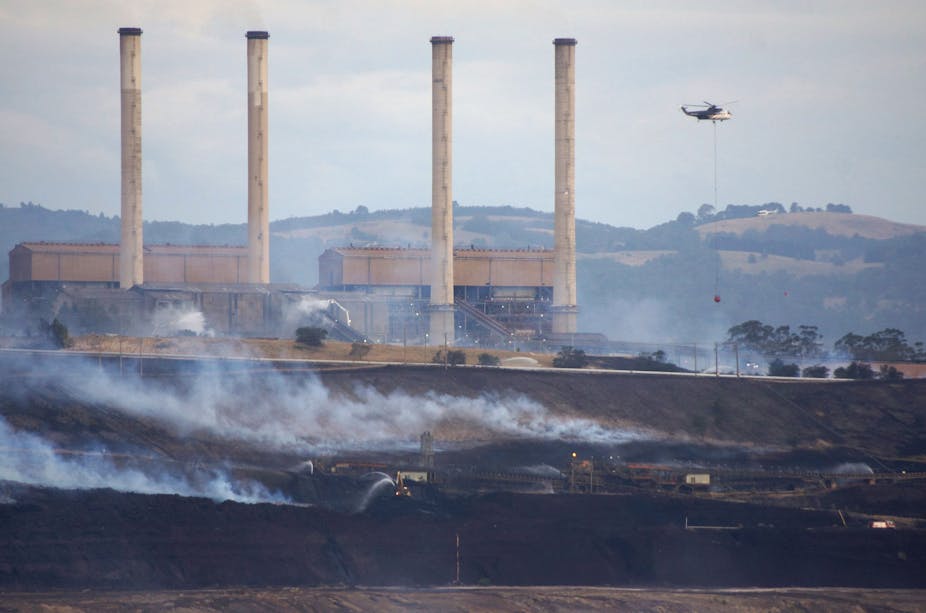Fittingly for a report on a huge fire, the findings of the Hazelwood Mine Fire Inquiry act as a smokescreen for the bigger issues behind the disaster.
Partly because of its narrow terms of reference, the inquiry viewed the 45-day fire as an “emergency event”, similar to other previous botches and disasters. But this approach ignores the wider point: that the real risks of brown coal can’t be managed.
As the inquiry found, the disaster could have been easily avoided. This might leave us with the impression that, with certain minor measures, such a fire will never happen again because the danger was so clearly foreseeable.
But “foreseeable” doesn’t always mean “preventable”. Sometimes it just means realising the risks and deciding to accept them, much like farmers are told to accept the possibility of drought as a normal business risk.
Where brown coal is concerned, accepting the risks means accepting crises like fires and pollution as normal – a condition, not an event. Is that really what we want?
Power plays
In his 1984 book Normal Accidents, Yale University sociologist Charles Perrow wrote that “the issue is not risk, but power”. That phrase is particularly apt for Hazelwood: a power station as well as a mine, only open by virtue of the power of vested interests.
Brown coal fails all tests of being a suitable energy source except for its apparent cost. Thanks to its environmental and human costs being radically discounted or completely ignored, brown coal appears delightfully cheap.
But of course, it is not actually cheap. As Tim Flannery and Fiona Stanley recently pointed out, residents in coalmining regions often suffer from a range of health problems, which impose huge costs on people and society alike. Studies of children show increased levels of neurotoxins like lead and mercury, alongside other pollutants.
Living in fear of insidious, silent toxins can be a lasting effect of a human-induced disaster. It is a characteristic of what another Yale sociologist, Kai Erikson, has called “a new species of trouble” facing modern society.
As the Hazelwood inquiry shows, efforts to tame this new species include presenting the problem as one with preventable causes. As Erikson explains, there is always a moral to be drawn, always some blame to be assigned, always a story to be told.
But the real story of Hazelwood is much bigger than the one told in the 450-odd pages of the commission’s report. The mine is not just the setting for the story; it is its lead character, protagonist, and victim.
The power of the mine in the story is illustrated by the way it reframes the value of native trees in the landscape. Over numerous pages, the report describes eucalypts within a wind’s breath of the mine as a future risk to it. The rationale is that they are flammable and, if alight, may release embers that subsequently reach and ignite the mine.
In this way, the report not only normalises the unquestioned ongoing importance of the mine, but also places the trees at risk by raising the possibility of their removal in the name of disaster risk reduction. The mine and its vulnerability to fire cast another haze over the landscape: a risk haze that darkens our view of otherwise positive elements such as trees.
Native trees being benighted on account of posing a distant risk to a large polluting coal mine is deeply ironic. Not only are such trees part of the original vegetation of the land, they are flammable because fire is a natural part of the Australian landscape. But now it is fossil fuel combustion that is naturalised, while bushfire has been perverted by climate change.
The hole in the story
And so we come to the other gaping hole (besides the mine itself) in the inquiry’s version of the story: climate change. It’s difficult to avoid the suspicion that the report’s silence on climate change is political. If so, it wouldn’t be a surprise, but it would be damaging.
The increasing frequency of extreme fire weather is mentioned in the report, but climate is not. So the fact that such “extreme” days are emerging on the back of increasing aridity, droughts and water shortages is omitted, which in turn allows water-intensive fire prevention and firefighting plans to be presented as rational.
Carbon is also mentioned in the report, but only in relation to the localised and short-term issue of carbon monoxide. The megatonnes of carbon dioxide released into the atmosphere during the 45 days of the fire, which will go on to threaten the health of people everywhere, are ignored.
Allowing climate change into the story lets in a dense cloud of other issues. It radically extends our sense of which communities have been affected by the fire. It forces the story out of its neat linear sequence and into a dizzying spiral of feedbacks.
Above all, the Hazelwood mine fire is a feedback effect of climate change. The mine itself has become the scene of a head-on collision between the status quo and the need to adapt.
A double disaster
Erikson warned that those directly exposed to human-induced disasters such as the Hazelwood fire often experience a loss of sense and meaning. This experience of an altered, disordered world can transform an initial disaster into a double one. Already, the quality of life of those living in mining regions is depressed daily by the mines, which harm the environment, damage health, and entrench socioeconomic disadvantage. To quote John Lennon and Harry Nilsson, life can feel like “trying to shovel smoke with a pitchfork in the wind”.
In a sense, the Hazelwood mine fire and its subsequent inquiry represents a double disaster for all of us. Shaped by politics, the inquiry’s efforts to frame the fire as an emergency event similar to any other misses the point: that brown coal presents huge dangers no matter how we govern it. We have to stop hiding this new species of trouble in our midst.

